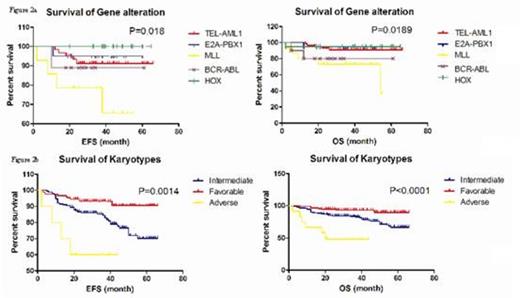Abstract
Background and purpose CCLG-2008 protocol has been carried out for more than 5 years in most parts of China. This retrospective cohort study analyzed the clinical features and the role of prognosis index on the outcomes of patients with childhood acute lymphoblastic leukemia (ALL) treated by CCLG-2008 protocol in the Children's Hospital of Soochow University, Suzhou, China.
Procedure From 2009 to 2013, 379 evaluable patients were enrolled in this protocol. ALL diagnosis was made by MICM and early prognosis index including age, gender, white blood cell (WBC), immunotype, molecular findings, karyotype and prednisone response were evaluated as predictors of adverse events by using SPSS 16.0. P-values <0.05 were considered statistically significant.
Results The overall relapse treated with CCLG-2008 protocol was 17.4%, with 16.9% and 23.3% in B-ALL and T-ALL. Bone marrow, central nervous system and testis relapse counts for 95.4%, 3% and 1.52% respectively. Comparing with B-ALL (n=349), T-ALL (n=30) was associated with a high WBC (>100*109/L, P<0.001), increased age (>120 months, P=0.018), more adverse karyotype distribution, a poor prednisone response (P<0.001), high therapy-related death (TRD, P=0.044) and death risk (P=0.014), with a reduced 5-year EFS and OS (42.74±4.72 months vs. 58.13±1.10 months, 43.77±4.48 months vs. 58.38±1.07 months). The adverse molecular alterations such as SIL-TAL1 fusion gene and MLL gene rearrangement were more often to see in T-ALL subtype ,while TEL-AML1, E2A-PBX1 and HOX genes were prone to B-ALL (Table 1). We didn't find significant prognostic impact of clinical features in T-ALL, which may be due to our limited patients' cohort. Separately in B-ALL subtype, a high peripheral WBC counts (>100*109/L) or increased age (>120 months) showed higher disease-relapse risk than other groups (P=0.003, <0.001, respectively). Patients with TEL-AML1, E2A-PBX1 and HOX fusion genes had favorable clinical presentations, which had less WBC counts and were sensitive to prednisone treatment than those with BCR-ABL and MLL gene rearrangements. Moreover, favorable karyotypes also related to those with less WBC counts, decreased age, sensitive to prednisone and less TRD. The event free survival (EFS) and overall survival (OS) of the group older than 120 months was lower (p<0.001). According to peripheral WBC counts, 3 subgroups were divided, including 273 cases with WBC <50*109/L, 44 cases with WBC between 50*109/L and 100*109/L, 32 cases with WBC >100*109/L. Patients with WBC < 50*109/L displayed the best survival while those with WBC higher than 100*109/L had the worst survival (Figure 1). The results of molecular alterations detected by multiple RT-PCR suggested that the MLL gene related and BCR-ABL positive patients exhibited the worst trend for EFS and OS (Figure 2a). Those with favorable karyotypes exhibited prolonged EFS and OS (Figure 2b). 44 cases who were not responsive well to prednisone displayed a shorter EFS and OS (Figure 3). Cox regression analysis indicated that WBC count, age, karyotype and prednisone response are independent factors as prognosis index for pediatric B-ALL treated by CCLG-2008 protocol .
Conclusions Patients with T-ALL subtype often had higher risk factors, such as high WBC counts, increased age, adverse genes and karyotypes. It is more prone to resistance to prednisone and disease relapse, and has a poor survival outcome. WBC count, age, karyotype and prednisone response are independent factors in predicting prognosis at initial stage of B-ALL. Patients with either very high WBC ¡Ý100*109/L or older than 120 months have short survival and need more intensive therapy or novel drug combination regimen to improve their EFS and OS.
EFS and OS of patients with different number of WBC. Patients with WBC >100*109/L have the shortest survival.
EFS and OS of patients with different number of WBC. Patients with WBC >100*109/L have the shortest survival.
a EFS and OS of B-ALL patients with fusion gene positive or negative.
a EFS and OS of B-ALL patients with fusion gene positive or negative.
Figure 2b EFS and OS of B-ALL patients with different risk of karyotype.
EFS and OS of patients with different response to prednisone.
EFS and OS of patients with different response to prednisone.
No relevant conflicts of interest to declare.
Author notes
Asterisk with author names denotes non-ASH members.




This feature is available to Subscribers Only
Sign In or Create an Account Close Modal